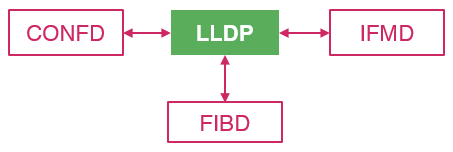Introduction to LLDP
Link Layer Discovery Protocol (LLDP) is a media-independent link layer protocol used by network devices for advertising their identity, capabilities to neighbors on a LAN segment. LLDP runs over the data-link layer only, allowing two systems running different network layer protocols to learn about each other.
LLDP supports a set of attributes that it uses to discover neighbor devices. These attributes contain type, length, and value descriptions and are referred to as TLVs. LLDP supported devices can use TLVs to receive and send information to their neighbors. Details such as configuration information, device capabilities, and device identity can be advertised using this protocol.
Guidelines
-
All LLDP packets are sent to the CPU for further processing.
-
LLDP packets will be lower priority packets when compared with the routing protocol packets. In case of a congestion, the LLDP packets may be policed.
Limitations
-
LLDP currently does not intend to work on bundle interfaces.
-
LLDP is disabled for the following interfaces on L2BSA L2X:
-
Physical interfaces on Q2C platform
-
LAG member interfaces on QAX platform
-
Interactions with other features
RBFS provides various daemons that run as background processes. LLDP interacts with these daemons for accessing necessary configurations.

The table below shows the interactions of LLDP with the other daemons of RBFS.
| Daemon Name | Daemon Description | Interaction Details |
|---|---|---|
Confd |
Configuration |
Confd stores all the LLDP configuration information. LLDP subscribes for the following tables of Confd:
|
IFMD |
Interface Monitoring |
LLDP is enabled on the physical interface. LLDP subscribes to the IFP table to find the status of the physical link. An LLDP message can be sent only to those interfaces whose link state is UP. |
FIBD |
Forwarding Information Base |
FIBD subscribes for the LLDP interface table which has all the information required for enabling LLDP on the interface. This is used to program in VPP. Any neighbor detected, VPP will notify and this detection is stored in the FIBD table for tracking purpose. Each time a message is received from the neighbor, it will be updated in this table. Thus, the history of the messages received from the neighbor is tracked. This information is stored in one of the FIBD tables. LLDP subscribes to this table to find its neighbor. |
LLDP Limitations with L2X
LLDP is disabled in the following scenario:
-
The outgoing-interface is configured in the egress L2X.
-
The outgoing-interface is configured in the ingress L2X with the match-type as "any" or "untagged".
-
The outgoing-interface and incoming-interface are configured in the bi-directional L2X.